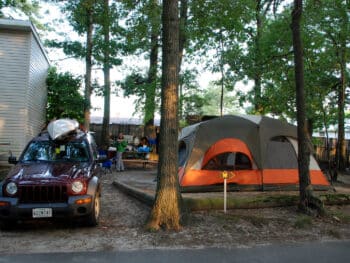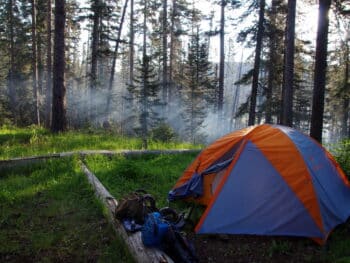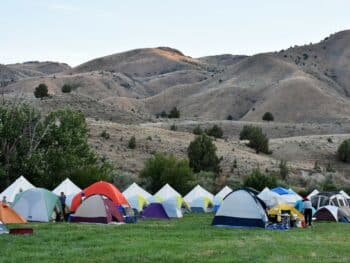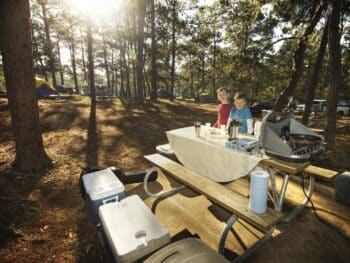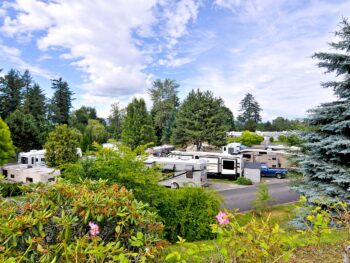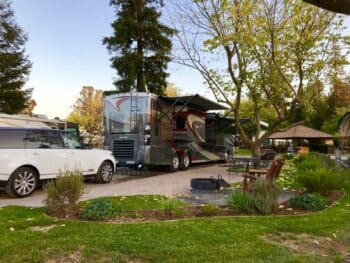Camping is a terrific way to connect with nature and stay somewhere for far less than the cost of a hotel. Every state in the U.S. offers campgrounds of all sizes and amenities. There are those catering to big-rig RVs with full hookups, while others are tucked away down a dirt road ideal for pitching a tent away from the crowds. Prices vary too, from free all the way up to over a hundred bucks a night depending on the real estate and facilities.
Camping by State
Whatever camping experience you’re looking for, be it the high mountains of Colorado and North Carolina, or the beaches of California and Florida, America’s got it. If you’re looking to stare up at the stars at night, consider getting far away from the city lights, the higher in elevation the better. Even if you’re without your own gear, you can likely rent a tent, RV, or travel trailer nearby to most cities.
Top Camping by City
Featured Campgrounds
Where To Go Camping in America
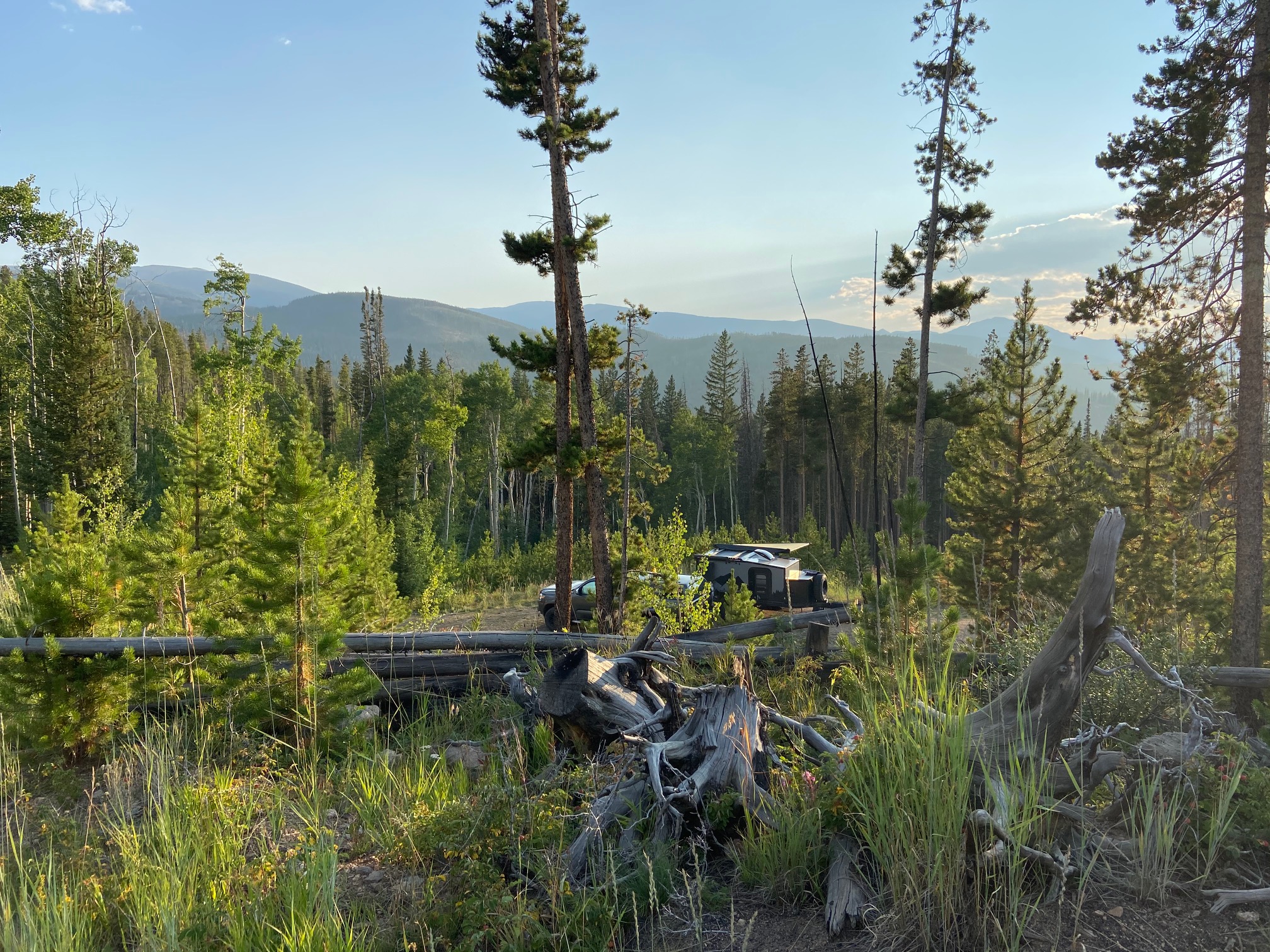
The United States offers a wide variety of climates and outdoor activities, meaning camping is possible year-round. Whether you’re on a months-long road trip or just have a night to spare, there’s good camping in almost every corner of the US.
America is the third-largest country by population and the third or fourth-largest by land area (Russia, then Canada, then China or the US, depending on the source). As such, it has a wide range of ecosystems to enjoy, and there’s a section of the country to comfortably camp in any time of year.
Sections of the United States that experience four distinct seasons have a camping season of roughly late May through September. Anytime “camping season” in the United States is mentioned, it’s usually referring to those months from late spring to early fall.
Regions that have four distinct seasons tend to have a peak season of roughly Memorial Day to Labor Day weekend. However, regions like the Desert Southwest and the Southeastern United States will often have an inverse peak season where visitors head there from the late fall to early spring, so “peak season” can vary. Of course, camping season can be year-round in temperate regions like Hawaii and Southern California, though that’s definitely the exception.
Summer Camping

West
The best summer camping destinations are going to depend on your preferences for scenery and how much heat you’re willing to endure. Utah is beautiful, but the Mighty Five National Parks can get quite warm in the midday summer sun. The same goes for Nevada, though spots like Reno and other central to northern sections of the Silver State don’t see the same triple-digits that Las Vegas does.
For most travelers, the northern portion of the West is going to be the most comfortable. The Pacific Northwest (and Northern California), along with the northern sections of the Mountain West are some of the top areas for summer.
The aforementioned regions tend to benefit from moderate summer weather and long, sunny days. If you choose to head to the coastal areas of the Pacific Northwest, the weather will be even milder, though usually more humid. The Mountain West can get quite warm in the summer, but northern states like Montana and Wyoming have relatively more manageable summers.
With Olympic, Glacier, Yellowstone, and Rocky Mountain national parks in these regions, they also hold some of the premier natural landmarks in the country. Though the Western US is generally hot during the summer months, heading up in elevation will allow you to experience comfortable temperatures in otherwise hot places.
States like Arizona, for example, get well into triple digits during the summer. However, higher elevations, like Flagstaff in this example, still have moderate temperatures. If the elevation isn’t appealing, staying in the Pacific Northwest is probably your best bet.
Alaska, though difficult to get to, is one of the most breathtaking places to spend the summer months. The weather is rarely above 75 in any section of the state, and the popular destinations in the southeast rarely get above the mid-60s F. With nearly 24 hours of daylight at the summer solstice, there’s no better place to spend time outside for long sunny days.
If you’re visiting Alaska (as well as Montana, Idaho, Wyoming, and Washington), know that you’re in grizzly bear country. Unless you have a hard-sided camper (and even then, use discretion), you don’t want to camp too far off the beaten path. Tent camping in popular spots, like Denali and Yellowstone National Parks, though, is safe if you use proper precautions.
Southwest
The Southwest is going to be comfortable in higher elevations, and that’s pretty much it. Northeast New Mexico, northern Arizona, and the Guadalupe Mountains are all going to be relatively comfortable destinations in the warmer months, but expect hot and dry weather (almost) everywhere else.
Eastern sections of Texas and Oklahoma have increased humidity and decreased temperatures compared to the rest of the Southwest. However, they still spend plenty of time in the mid-90s°F, so these areas are better saved for fall travel.
Midwest
The upper sections of the Midwest can be moderate summer destinations, especially the Dakotas, Wisconsin, Michigan, and Minnesota. The Upper Midwest benefits from long summer days, and there are plenty of areas there that don’t get much above 80°F at the warmest.
The Dakotas tend to be warmer and drier than the rest of the Upper Midwest, with the national parks in both North and South Dakota getting into the mid to upper 80s at the warmest. Even still, overnight lows can drop 25-30 degrees from mid-day highs, so the evenings are usually comfortable.
Southeast
Like the Southwest, your best bet here is to head up in elevation. However, the northern sections of this region, like West Virginia, Kentucky, and Virginia, have plenty to offer in terms of moderate summers. New River Gorge National Park rarely gets above 80, and Shenandoah National Park tends to be in the mid-70s during peak season.
Coastal areas, like Virginia Beach, do get warmer (mid-80s°F, usually) but have the benefit of the Atlantic Ocean and summer tourism spots. Consider any areas of the Appalachian Mountains, such as the Great Smoky Mountains National Park.
Northeast
Outside of the West, the Northeast is the place to be during the summer. The days are long, and the coastal weather is refreshing. While you can enjoy the western sections of this region, coastal states, especially in New England, are going to be maximally comfortable.
Acadia National Park, though crowded in peak season, is a great Northeast destination to head for the warmer months. Coastal Maine, in general, is a stunning spot to visit this time of year. Like all other areas, though, increasing elevation and latitude is going to decrease temperatures.
Fall Camping

Northeast
There’s a clear answer here: New England. Acadia National Park (and really anything in the Northeast) is incredible during the fall. However, leaf-peepers head here in droves when the colors start to come in, so you’ll be dealing with some serious crowds. Those wanting to avoid crowds but enjoy crisp fall weather and great colors should consider state parks and national forests in New England.
Southeast
Heading further south, any Appalachian state will also be an ideal place to see fall colors with milder weather. Great Smoky Mountains National Park is another popular fall spot, though it also comes with crowds. North Carolina, Tennessee, Virginia, and West Virginia are all outstanding options for Southeast during early fall, and later fall South Carolina and Georgia are exceptional.
Midwest
The Upper Midwest is another contender during the fall but tends to be a colder option than much of the Appalachian area. Michigan is renowned for its fall colors and its autumn hiking but be sure to bring warm gear when heading to this region.
Most of the southern section of the Midwest is a good fall spot as well, but the northern section is still the region’s crown jewel. Anywhere that isn’t western Nebraska or western Kansas is a good spot to see fall colors in the Midwest, though you’re better off heading somewhere else during early fall and saving the southern Midwest for later in the season or the springtime.
Southwest
If you’re looking to follow the leaves, the Southwest is going to be best late in the season. Fall colors move south, and down in elevation, so the earliest fall changes are in the far north, and the southern United States is at the end of the season. Of course, that does make it fairly straightforward to follow fall colors.
While you won’t get a spectacular display of colors throughout the entire region, there are still some great spots, especially in East Texas and Northern Arizona.
What the Southwest lacks in fall foliage, it makes up for in warmer weather. While the high-elevation areas are already cold, the lower elevations still have comfortable temperatures for the most part. The southern sections of New Mexico, Arizona, and Texas all have plenty of warm weather well into late fall.
West
In the west, the northern sections (and the higher elevations) put on spectacular shows during the fall. Anywhere with early season fall colors will already be fairly chilly and towards the end of the traditional season, so expect camping to start becoming limited.
Alaska offers beautiful colors in the tundra, but anything past the early season is going to be colder than most travelers will want to handle, and accommodations tend to be in short supply past September.
States like Montana and Wyoming, while beautiful, will likely have snowfall, especially if it’s a colder-than-average year. Prepare for cold weather camping, even during the early parts of the season, if you’re in the Mountain West.
Don’t count out Utah as a fall destination. While it can get cool, it’s generally still manageable in the earlier season. While not the absolute best spot for fall colors in the West, it’s a terrific time to visit the Mighty Five after the crowds have mostly left. Spring is another good option (more on that later), but early fall sees the crowds thin out, though the park is still fully open.
Winter Camping

Southeast
Head south for the winter. More specifically, head to the South. South Carolina, Florida, and all states that border the Gulf of Mexico see moderate winter temperatures. Florida’s national parks are more crowded during the winter for this exact reason.
If you’re trying to escape the cold, though, the South is where you want to be. Consider Congaree National Park in South Carolina for something less crowded.
Note that anywhere on the eastern seaboard can get cold. Even northern Florida can drop below freezing from time to time. Anything south of Orlando, especially towards the southern tip of the Sunshine State, is going to be much more moderate and past the frost line.
Throughout the Southeast, the northern sections of the state (sometimes the state in general) see colder temperatures all season. The closer you are to the Gulf of Mexico, the more comfortable the winter.
The traditional camping season is still from late May trough September. Even if the weather is moderate, don’t assume that campgrounds are open year-round.
Southwest
Texas, especially in the eastern half, follows the same logic as the Southeast. The further southeast you go in the Lone Star State, the more moderate the winter. For the rest of the Southwest, this season can be bitingly cold, with a few exceptions.
Even areas like Tucson, Arizona that have highs in the mid-60s can get down to freezing overnight. Desert spots, even with moderate daytime temperatures, can drop 30 degrees overnight.
West
Of course, those who want to experience winter will have no shortage of options for winter camping and snow sports. Wyoming, Montana, and Colorado are all good options for those looking to enjoy the snow. States with large quantities of snowfall will have limited camping and, in some cases, generally inadvisable. Dispersed winter camping, while exciting, is best left to the experienced in this region.
Southern California is a great spot for mild winters and year-round accommodations. The same goes for Arizona. As long as you avoid the high elevations, campgrounds tend to be available all year long.
Midwest
While you might be able to camp in the southernmost parts of the Midwest, it just isn’t the ideal spot this time of year. Few accommodations are going to be open, and most of the region is blanketed in snow, so consider other states.
Northeast
The Northeast is similar to the Midwest here. There are some year-round accommodations, and the most hardcore adventurers may want to head to the Northeast now. However, the interest in camping (and the availability of campsites) is quite low past the end of the traditional season.
Spring Camping

West
Southern California and the southern sections of the Mountain West are probably the best choices early in the season. The later in the spring, the further north you can move. Outside of the warmest section of this region, there isn’t a whole lot around until the end of May at the earliest.
If you want to beat the crowds, you’ll need to brave the cold. However, there’s often snow, even at relatively low elevations, so have backup plans in place. If nothing else, there’s always Hawaii.
Southwest
Similar to the West, only the warmest parts of the region will be available in early spring. Generally, it’s simpler to wait until at least mid-way through the season when campgrounds start to open up. Though early season campers who want to boondock will have plenty of options in the Southwest.
While the overnight lows in the region will still be fairly chilly, daytime temperatures are cool to comfortable through most of it by mid-spring. One caveat is to avoid spring break, if possible, as national parks are often crowded during that time. If you aren’t visiting parks like Big Bend or Joshua Tree National Parks, this isn’t as much of an issue.
Those exploring Utah may debate between fall and spring. Spring may be slightly more comfortable and less crowded, but there are often more weather-related closures in spring than in fall. While it’s not a guarantee, fall is usually a bit safer of a bet than spring. Anything from southern Arizona to west Texas is worth seeing in spring, especially if traveling during wildflower season.
Southeast
The southern sections of this region, which are more moderate year-round, are a good choice here. RV travelers should have some luck with parks being open year-round, though tent campers may have sparser options if looking for more remote sites.
The northern section, however, is going to open later in spring. You can beat the crowds in some of the national parks here by going in the mid to late spring before peak season, just double-check all the campgrounds. Most national parks will keep at least one of their loops or campgrounds open year-round.
Midwest
In early to mid-spring much of the Midwest is too cold to be comfortable. The northern section is incredibly seasonal, so amenities are sparse. If you want to see some of the national parks in the Dakotas, you can have the place more to yourself if you’re willing to gear up for the cold. Other than that, it’s best to wait until the very end of spring.
Northeast
Similar to the Midwest, seasonal amenities here tend to show up late in the spring, especially for seasonal New England destinations. Outside of taking trips to the major cities, the Northeast is usually best saved for early summer.
Coastal destinations in New England and New Jersey can be very pleasant this time of year, but be sure accommodations are going to be available. For those looking to explore the Keystone State, consider camping in Southeastern Pennsylvania where the weather is warmest year-round.
National Park Service Sites in the United States
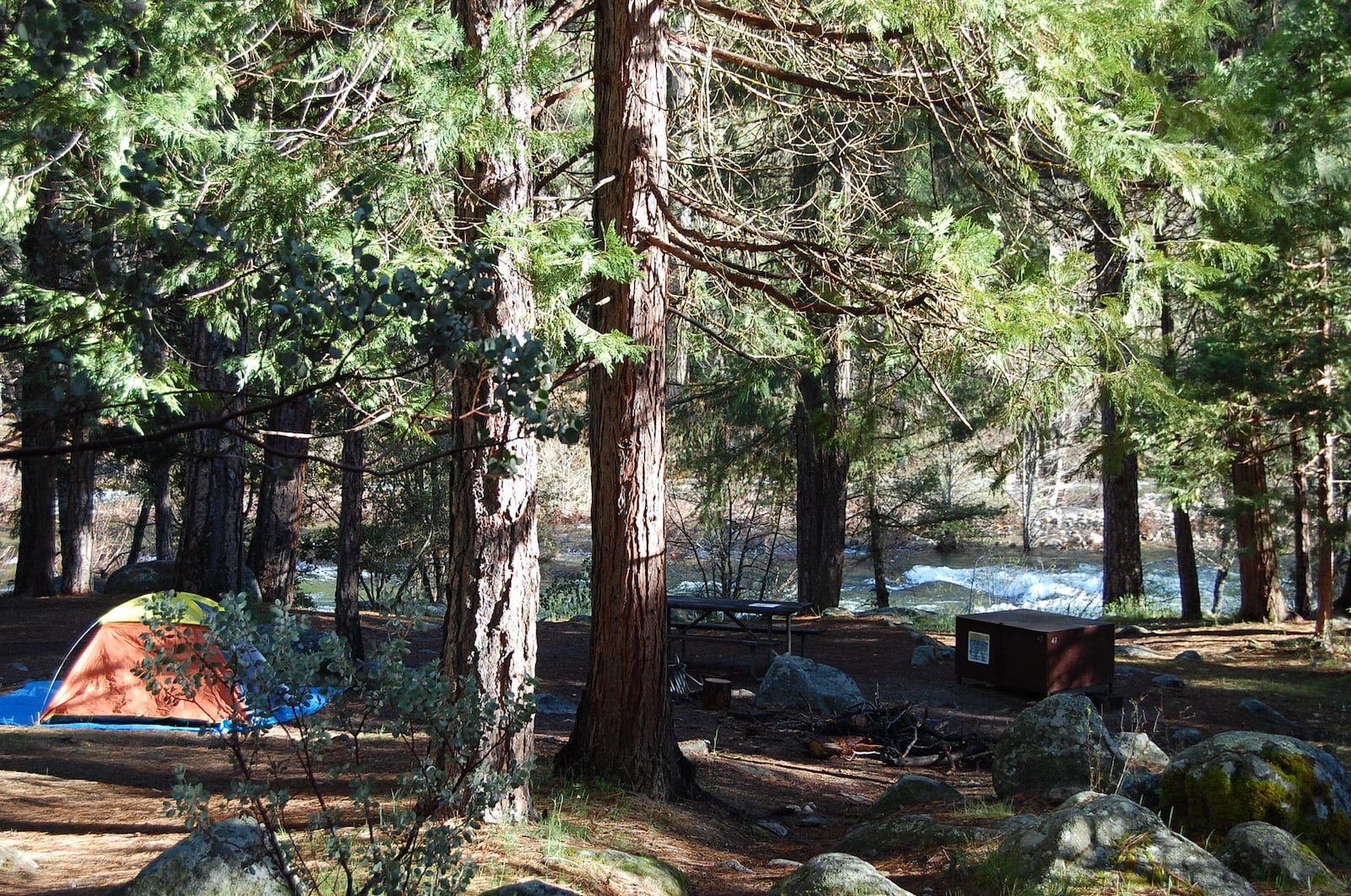
The world is filled with incredible national parks, and the United States holds some of the most famous and breathtaking of all. The US has 423 total National Park Service (NPS) sites, including 63 national parks.
While the National Park Service itself was established by President Woodrow Wilson in 1916, there were national parks before the NPS existed. In 1872, President Ulysses S. Grant signed the Yellowstone National Park Protection Act, which established the first national park in the United States. Several other national parks followed, with 11 total national parks in existence before the NPS was established.
While all 63 have something unique and exciting to offer, these 10 should be on every camper’s bucket list.
- Yosemite National Park
- Yellowstone National Park
- Acadia National Park
- Grand Canyon National Park
- Glacier National Park
- Great Smoky Mountains National Park
- Rocky Mountain National Park
- Olympic National Park
- Zion National Park
- Denali National Park
National Forests in the United States

Almost 200 million acres of the United States are covered by the 154 national forests (and 20 national grasslands) managed by the United States Forest Service (USFS). For reference, the state of Texas is about 172 million acres.
The USFS actually predates the National Park Service by 11 years. President Theodore Roosevelt established the Forest Service as a division of the United States Department of Agriculture (USDA) in 1905. Two years later, almost 100 million acres were given to the USFS to manage.
National forests are some of the prime places to go to skip the crowds in the most popular national parks, as well as find great free camping throughout the US. Most of the federal land in the US is located west of the Mississippi River, mainly due to states like Alaska, California, and Idaho, each having around 20 million acres of national forest land. While you can find national forests east of the Mississippi, there aren’t nearly as many.
40 of the 50 US states have national forests, with six of those without national forests located east of the Mississippi. Technically, Kansas and North Dakota don’t have national forests, though they do have national grasslands. Of the 154 national forests, here are 10 of the best.
- Tongass National Forest
- Coconino National Forest
- Pisgah National Forest
- White Mountain National Forest
- Bridger-Teton National Forest
- Sierra National Forest
- Dixie National Forest
- Superior National Forest
- White River National Forest
- Sequoia National Forest
Best Free Camping in the United States

Roughly 28% of the United States is owned by the federal government, with the Bureau of Land Management and the United States Forest Service managing the bulk of federal free camping land. Typically called dispersed camping, primitive camping, or simply boondocking, it tends to be much more prevalent in Western states than those in the East.
Almost half of the land located in the eleven contiguous Western states (Arizona, California, Colorado, Idaho, Montana, Nevada, New Mexico, Oregon, Utah, Washington, and Wyoming) is managed by the federal government. Nevada has the most federal land in the US, with almost 80% of its land managed by federal government entities, mainly the Bureau of Land Management (BLM).
Outside of those contiguous Western states, Alaska has 61% of its land managed federally. With so many great spots to free camp in the US, here are 10 to add to your list.
- Cebolla Mesa in the Carson National Forest
- Pumphouse Wash in the Coconino National Forest
- Badlands Overlook (also known as Nomad View)
- The Alabama Hills
- North Creek BLM Dispersed Camping
- Piney Lake in the White River National Forest
- The Main Drag (National Forest Road 525)
- Wedge Overlook Dispersed Camping
- Jackson Mountain Road in Pagosa Springs, Colorado
- Valley of the Gods near Mexican Hat, Utah
United States State and Public Parks

The US has over 6,000 state parks, which serve more than twice the visitorship of the National Park Service sites. Though state parks have 16% of the total land that the NPS has, it’s a much more popular system, statistically. All 50 states have state parks, with Rhode Island coming in last place at 15.
Though larger states often have more state parks, that isn’t necessarily how you should put together a state parks road trip. While California has the most state parks at 270, Connecticut only has 10 fewer than Alaska (109 and 119, respectively).
Getting the most bang for your buck can mean planning your road trip around one state and seeing all of its best parks. If that’s the case, consider the top 10 states with the most state parks. Though there’s no nationwide pass, unlike the NPS and USFS systems, it’s worth the price of admission to get into any of these 10 state parks; though you often can purchase an annual state park pass good for the entire state.
- Redwood State Park
- Waimea Canyon State Park
- Letchworth State Park
- Chugach State Park
- Hocking Hills State Park
- Dead Horse Point State Park
- Red Rock State Park
- Custer State Park
- Palo Duro Canyon State Park
- Valley of Fire State Park
RV Resorts and Unique Stays

The US has a wide network of RV resorts, glamping getaways, and unique stays. Oftentimes, cities near national parks or other major outdoor destinations have the most unique stays available, but that isn’t the case unilaterally. While it’s usually best to decide where you want to go and then plan for accommodations, these 10 spots are destinations in and of themselves.
- Angel Fire RV Resort in New Mexico
- The Views RV Park & Campground in Colorado
- Dark Sky RV Campground in Utah
- Carolina Pines RV Resort in South Carolina
- Sun Outdoors Rocky Mountains in Colorado
- Lake Siskiyou Camp Resort in California
- Fortland in Maine
- Yellowstone Hot Springs in Montana
- Asheville Glamping: Treehouse and Dome Glamping in North Carolina
- Moose Meadow Lodge & Treehouse in Vermont
It’s easy to spend a lifetime traveling through the United States without seeing all it has to offer. In fact, it would be hard to see every special nature spot in the US in one lifetime, period. While you may never see all it has to offer, this country does give you a myriad to choose from.








